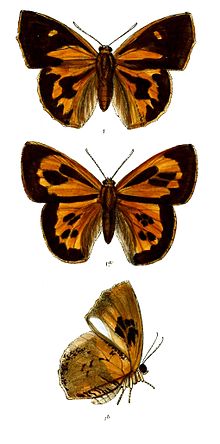
Butterflies (Rhopalocera) are insects that have large, often brightly coloured wings, and a conspicuous, fluttering flight. The group comprises the superfamilies Hedyloidea and Papilionoidea. The oldest butterfly fossils have been dated to the Paleocene, about 56 million years ago, though they may have originated earlier.

Papilio is a genus in the swallowtail butterfly family, Papilionidae, as well as the only representative of the tribe Papilionini. The word papilio is Latin for butterfly.

Lycaenidae is the second-largest family of butterflies, with over 6,000 species worldwide, whose members are also called gossamer-winged butterflies. They constitute about 30% of the known butterfly species.

Graphium is a genus of mostly tropical swallowtail butterflies commonly known as swordtails, kite swallowtails, or ladies. Native to Eurasia, Africa, and Oceania, the genus is represented by over 100 species. Their colouration is as variable as the habitats they frequent; from rainforest to savannah. Some possess tails which may be long and swordlike, while others lack any hindwing extensions. Graphium species are often sighted at mud puddles.

Ornithoptera alexandrae, the Queen Alexandra's birdwing, is the largest species of butterfly in the world, with females reaching wingspans slightly in excess of 25 cm to 28 cm. This birdwing is restricted to the forests of the Oro Province in eastern Papua New Guinea.

Gracillariidae is an important family of insects in the order Lepidoptera and the principal family of leaf miners that includes several economic, horticultural or recently invasive pest species such as the horse-chestnut leaf miner, Cameraria ohridella.

The rajah and pasha butterflies, also known as emperors in Africa and Australia, make up the huge type genus of the brush-footed butterfly subfamily Charaxinae, or leafwing butterflies. They belong to the tribe Charaxini, which also includes the nawab butterflies (Polyura). Charaxes are tropical Old World butterflies, with by far the highest diversity in sub-Saharan Africa, a smaller number from South Asia to Melanesia and Australia, and a single species in Europe. They are generally strong flyers and very popular among butterfly collectors.

Miletinae is a subfamily of the family Lycaenidae of butterflies, commonly called harvesters and woolly legs, and virtually unique among butterflies in having predatory larvae. Miletinae are entirely aphytophagous. The ecology of the Miletinae is little understood, but adults and larvae live in association with ants, and most known species feed on Hemiptera, though some, like Liphyra, feed on the ants themselves. The butterflies, ants, and hemipterans, in some cases, seem to have complex symbiotic relationships benefiting all.

Hestina is a genus of butterflies in the family Nymphalidae subfamily Apaturinae. The genus is found in the East Palearctic and Southeast Asia.

Consul, described by Pieter Cramer in 1776, is a South American nymphalid butterfly genus in the subfamily Charaxinae.
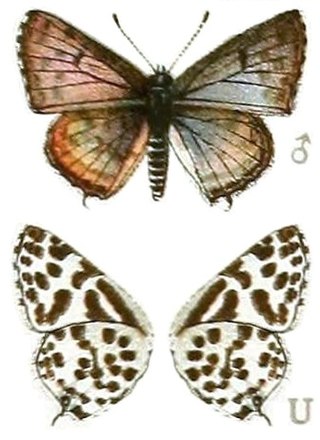
Zintha is a butterfly genus in the family Lycaenidae. It is monotypic, with the only species being Zintha hintza, the blue-eyed Pierrot, blue pied Pierrot or Hintza blue. The pied Pierrots proper are the closely related genus Tuxentius, however, and like Zintha they were formerly included in Castalius.

Eupackardia is a monotypic moth genus in the family Saturniidae erected by Theodore Dru Alison Cockerell in 1912. Its only species, Eupackardia calleta, the calleta silkmoth, was described by John O. Westwood in 1853. It is found in Mexico, Guatemala, as well as in the states such as; Arizona, New Mexico, and Texas.

Precis is a genus of nymphalid butterflies that Jacob Hübner described in 1819. They are commonly known as commodores and are found in Africa. Two species are endemic to Madagascar.
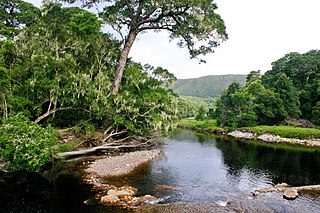
Papilio euphranor, the forest swallowtail or bush kite, is a butterfly of the family Papilionidae. It is found in southern Africa.
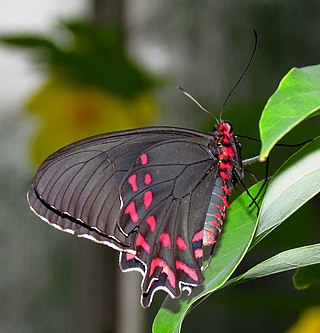
Parides photinus, the pink-spotted cattleheart, is a species of butterfly in the family Papilionidae. It was first described by Edward Doubleday in 1844.

Synemon is a genus of moths within the family Castniidae. It was described by Edward Doubleday in 1846. The genus contains 24 described and 20 undescribed species. These species are found across mainland Australia and on Kangaroo Island, with the highest diversity in Western Australia. Synemon species can be found in a range of habitats, including woodlands, heathlands and native perennial grasslands. The adults fly during the daytime in warm to hot weather. They have clubbed antennae, and are often mistaken for butterflies.
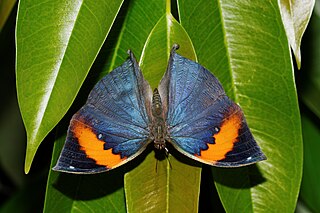
Kallima paralekta, the Indian leafwing or Malayan leafwing, is a species of brush-footed butterfly of the genus Kallima. Despite its common names, it is not found in India or Malaysia, but is endemic to Java and Sumatra of Indonesia. Like other members of its genus, it is remarkable for its strong resemblance to a dead leaf when its wings are folded. It was one of the species encountered by the British naturalist Alfred Russel Wallace in his travels in maritime Southeast Asia. It is mentioned in his famous 19th-century work The Malay Archipelago as one of the best examples of protective camouflage achieved through natural selection.
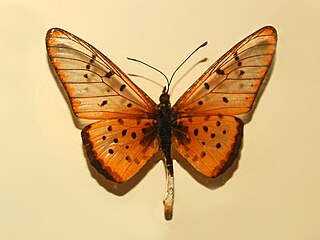
Acraea pseudegina is a butterfly of the family Nymphalidae, which is native to the African tropics and subtropics.

Xanthotaenia is a monotypic butterfly genus in the family Nymphalidae. Its single species is Xanthotaenia busiris, the yellow-banded nymph. They can be identified by a yellow strip along their forewings.

Parides agavus, the Agavus Cattleheart, is a species of butterfly in the family Papilionidae. It is found in Brazil, Paraguay, and north Argentina.
